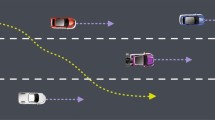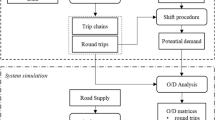Abstract
Vehicular ad hoc network (VANET) is expected one of promising network forms for intelligent transportation system which supports road safety applications, in-vehicle entertainment and arriving automatic driving. Establishing and maintaining stable connections in VANETs are challenging on account of the high mobility of vehicles, dynamic vehicle topology, and time-varying vehicle density. Clustering can provide scalability and reliability for VANETs by grouping vehicles with hierarchical structures. However, keeping cluster stable became a hard nut to crack due to high vehicle speed and unpredictable driving pattern. Recent rapid development of artificial intelligence (AI) provided an innovative solution for this situation. In this paper, a Naive Bayes Classifier based driving habit prediction scheme for stable clustering is proposed, briefly named NBP. According to driving speed and overtaking decisions, vehicles are classified into two alignments with different driving habit. Specifically, Naive Bayes classifier perform driving habit prediction through several relative independent factors, such as relative velocity, vehicle type, number of lanes traveled. The cluster head candidates will be chosen from alignment with mild driving pattern which will benefit for stable clusters. Combined with clustering design, the proposed method has been proven effective for stable clustering in VANET based on the real data of highways in California.






Similar content being viewed by others
References
Karagiannis G, Altintas O, Ekici E, Heijenk G, Jarupan B, Lin K, Weil T (2011) Vehicular networking: a survey and tutorial on requirements, architectures, challenges, standards and solutions. IEEE Commun. Surv. Tutorials 13(4):584–616
Bitam S, Mellouk A, Zeadally S (2015) Bio-inspired routing algorithms survey for vehicular ad hoc networks. IEEE Commun. Surv. Tutorials 17(2):843–867
Han S, Huang Y, Meng W, Cheng L, Xu N, Chen D (2019) Optimal power allocation for SCMA downlink systems based on maximum capacity. IEEE Trans Commun 67(2):1480–1489
Eze EC, Zhang S, Liu E (2014) Vehicular ad hoc networks (VANETs): current state, challenges, potentials and way forward. In: In ICAC 2014 - proceedings of the 20th international conference on automation and computing: future automation, computing and manufacturing, pp 176–181
Han S, Zhang Y, Meng W, Chen H-H (2018) Self-interference-cancelation-based SLNR Precoding Design for Full-Duplex Relay-Assisted System. IEEE Trans Veh Technol 67(2):8249–8262
Han S, Xu S, Meng W, Cheng L (2017) An agile confidential transmission strategy combining big data driven cluster and OBF. IEEE Trans Veh Technol 66(11):10259–10270
Shea C, Hassanabadi B, Valaee S (2009) Mobility-based clustering in VANETs using affinity propagation, in IEEE global telecommunications conference. GLOBECOM 2009:1–6
Cooper C, Franklin D, Ros M, Safaei F, Abolhasan M (2017) A comparative survey of VANET clustering techniques. IEEE Commun. Surv. Tutorials 19(1):657–681
Azizian M, Cherkaoui S, Hafid AS (2016) DCEV: a distributed cluster formation for VANET based on end-to-end realtive mobility, in 2016 international wireless communications and Mobile computing conference. IWCMC 2016:287–291
Ren M, Khoukhi L, Labiod H, Zhang J, Vèque V (2017) A mobility- based scheme for dynamic clustering in vehicular ad-hoc networks (VANETs), vehicle. Communications 9:233–241
Ge X, Gao Q, Quan X (2018) A novel clustering algorithm based on mobility for VANET. 2018 IEEE 18th international conference on communication technology (ICCT 2018), pp 473–477
Rawashdeh ZY, Mahmud S (2012) A novel algorithm to form stable clusters in vehicular ad hoc networks on highways. EURASIP J. Wirel. Commun. Netw. 2012:1–15
Kannekanti SY, Nunna GSP (2017) An efficient clustering scheme in vehicular ad-hoc networks, in ubiquitous computing, electronics and Mobile communication conference (UEMCON), 2017 IEEE 8th annual, pp 282–287
Ucar S, Ergen SC, Ozkasap O (2016) Multihop-cluster-based IEEE 802.11p and LTE hybrid architecture for VANET safety message dissemination. IEEE Trans Veh Technol 65(4):2621–2636
Performance Measurement System (PeMS). [Online]. Available: http://pems.dot.ca.gov.
SUMO-Simulation of Urban Mobility [Online]. Available: http://sumo.sourceforge.net
Han S, Xu S, Meng W, Cheng L (2018) Dense-device-enabled cooperative networks for efficient and secure transmission. IEEE Netw 32(2):100–106
Mehmood A, Khanan A, Mohamed AHHM, Mahfooz S, Song H, Abdullah S (2017) ANTSC: an intelligent Naïve Bayesian probabilistic estimation practice for traffic flow to form stable clustering in VANET. IEEE Access 6:4452–4461
Lv Q, Qiao Y, Ansari N, Liu J, Yang J (2017) Big data driven hidden Markov model based individual mobility prediction at points of interest. IEEE Trans Veh Technol 66(6):5204–5216
Eiza MH, Ni Q (2013) An evolving graph-based reliable routing scheme for VANETs. IEEE Trans. Veh. Technol. 62(4):1493–1504
Krajzewicz D, Bonert M, Wagner P (2006) The open source traffic simulation package SUMO, in Proc. RoboCup Jun:371–380
NS-2 The Network Simulator 2. [Online]. Available: https://www.isi.edu/nsnam/ns/
Author information
Authors and Affiliations
Corresponding author
Additional information
Publisher’s note
Springer Nature remains neutral with regard to jurisdictional claims in published maps and institutional affiliations.
Rights and permissions
About this article
Cite this article
Liu, T., Shi, S. & Gu, X. Naive Bayes Classifier Based Driving Habit Prediction Scheme for VANET Stable Clustering. Mobile Netw Appl 25, 1708–1714 (2020). https://doi.org/10.1007/s11036-020-01580-w
Published:
Issue Date:
DOI: https://doi.org/10.1007/s11036-020-01580-w




